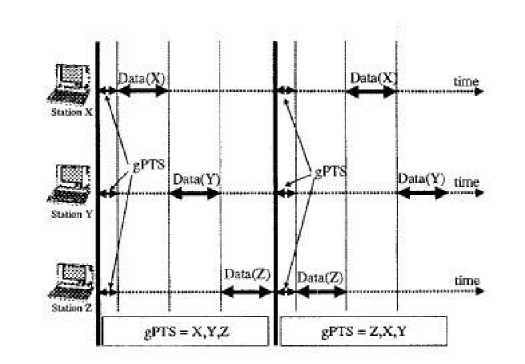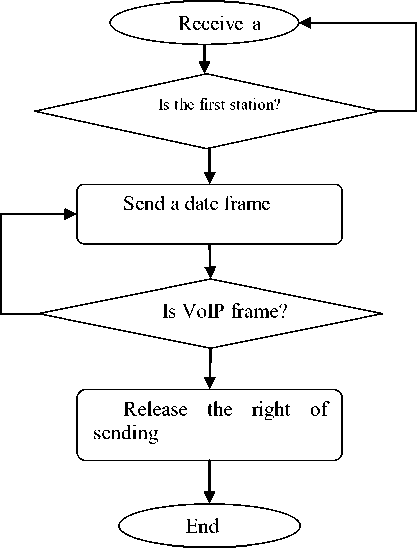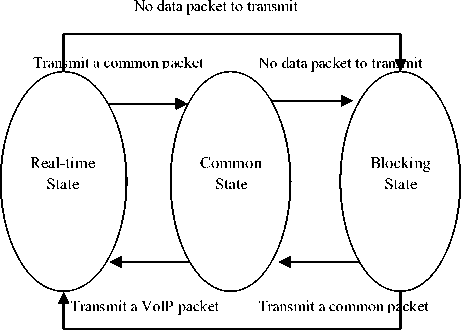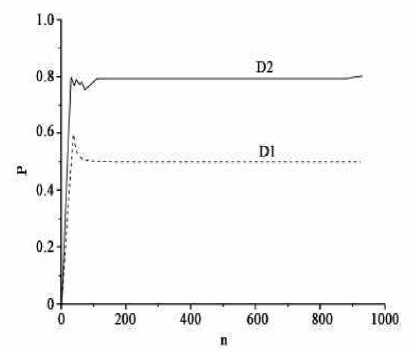The Research and Improvement of PCF Polling Scheme in VoWLAN
Автор: Qi Tan, Chao Huang, Minghe Huang
Журнал: International Journal of Education and Management Engineering(IJEME) @ijeme
Статья в выпуске: 4 vol.2, 2012 года.
Бесплатный доступ
VoIP over WLAN which is called VoWLAN is an application of VoIP based on WLAN. This article mainly researches the PCF polling scheme in the IEEE802.11 Protocol. An improved PCF polling scheme has been proposed to meet the requirement of real-time business. The improved PCF polling scheme is based on Superpoll algorithm, it uses the concept of priority service and combines with the PCF uplink algorithm. In the improved PCF scheme, the VoIP station and VoIP packet has a higher priority, they can get continuous services. According to the experiment of simulation software, the improved PCF polling scheme can support the real time business such as VoIP effectively, the time delay of the VoIP packet has been reduced, and the session quality of the VoWLAN has evidently improved.
VoWLAN, VoIP, WLAN, IEEE802.11, PCF, Superpoll
Короткий адрес: https://sciup.org/15013679
IDR: 15013679
Текст научной статьи The Research and Improvement of PCF Polling Scheme in VoWLAN
The VoIP[1] and WLAN[2] are both the popular network technology which is in the vigorous development. The VoIP has the characteristics of low cost and high quality service and the WLAN has the advantages of mobility, low-cost and being applied in the special environment. It would have widely development prospection which gathers the advantages of the above two technologies, which is called the VoWLAN[3].
Applied under wireless circumstance, VoWLAN must have the same communication quality as the wired VoIP. Only in that way can they meet the demand of consumers and markets. However, the original design of WLAN has not taken the real-time requirement of voice services into consideration. Thus, it can’t provide good support to the time delay-sensitive voice services. As a result, how to decline the average access delay of the voice packets in the VoWLAN becomes essential.
There are two channel access methods in the IEE802.11 protocol. One is distributed coordinating function which is called DCF[4] and the other is point coordinate function which is called PCF[5] which is optional. DCF
* Corresponding author.
can not meet the QoS of real-time business. PCF can assure that the stations access to the radio channel with certain priority, it can provide a service without competition.
Point Control, which is called PC, controls the transmission of the data packets in the PCF.PC usually stays in the access point which is called AP. There isn’t any detailed PCF Polling Algorithm defined in the IEEE802.11.The PC will poll the stations order by order according to the polling list in the base PCF Polling scheme, only be polled the station has the right of transmission. The station will transmit a data packet which contains the acknowledge packet to the polling packet when receiving it, and then the PC will poll the next station, transmit a polling packet to the next station, and the acknowledge packet to the last data packet is contained in the polling packet.
The based PCF scheme is so easy that there are many disadvantages with it, which are showed in the next paragraphs.
-
• AP doesn’t know the state of the station which is being polled.
-
• All of the data packets should be relayed by the AP.
-
• The scheme doesn’t define high priority for the real-time business such as VoIP.
-
• PC can only polls one station in one polling process, the expense of the system is too much.
-
2. Brief introduction of superpoll algorithm
The Superpoll algorithm is proposed by Aura Ganz, Anan Phonphome and Zvi Ganz in 1998.In the Superpoll algorithm, PC transmits a Superpoll Packet which contains all of the stations who want to transmit in the CFP, by this method, all of the stations will be polled in the CFP.
In order to support the real-time business such as VoIP, this paper proposes a new PCF Polling Scheme, which is based on the Superpoll algorithm[6]. The new PCF Polling scheme introduces the mechanism of different priority, and combines with the PCF Uplink algorithm. The new PCF scheme gives the stations which transmits real-time packets and the real-time packets a higher priority, so the real-time packets will get continued transmission and services of high priority, declines the time delay of the real-time packets from one station to the other, improves the efficiency of the VoWLAN.
The Superpoll algorithm is proposed by the observations of the single poll mechanism which is adopted in the protocol of IEEE802.11 PCF Protocol, it contains the following points:
-
• PC has to transmit a poll packet for every station. This will lead to excessive overhead to the VoIP system when the transmission time of the data packet is too short then the poll packet.
-
• The wireless channel is full of noise, this will lead to the mission of the poll packet and the station will not get the right of transmission. We must let the poll packets reach the stations as far as possible.
-
• The quality of the channel of every two station is different in the WLAN, which is decided by the performance parameters of the channel, so the poll packets can reach the target stations directly which need not delaying by the PC.
-
3. The improvement of PCF polling scheme
Every stations who want to transmit data packets in the CFP need to register in the period of competition in the Superpoll algorithm,PC maintains a polling list which contains all of the stations registered in the period of competition, PC determines the sequence of the polling list. At the beginning of the CFP, every non-PC stations adjust they NAV to the CFPMaxDuration, which is the most maintain time of the CFP, all the stations can not transmit data packets until they get the right of transmission. PC will transmit a superpoll packet which is called gPTS, with polling list included in it. The order of the polling list is determined by the PC, every registered station has an id which is unique. Every station that receive the gPTS will know they polling position in the polling list, the station which located at the first of the polling list own the right of transmission and will transmits a MAC Protocol Data Unit(MPDU) which contains a new polling list, with its id removed. If the MPDU is received by the objective station, it will transmit a acknowledge packet back to the source station. The other stations will know they polling position in the new polling list, the station which located at the first of the new polling list own the right of transmission and transmit a MPDU according to the above regular. This process will continue to the time that all of the registered stations have been polled. At the end, the PC will transmit a beacon of CF-End to inform all of the stations that the CFP is end. All of the stations will adjust their NAV when the CFP is end. The Fig.1 shows the operation of the SuperPoll algorithm.

Fig 1. The Superpoll algorithm Sequence Map
We propose a new improved PCF Polling Scheme on the base of Superpoll algorithm to support the QoS of real-time businesses such as VoIP.
In the improved PCF Polling Scheme, Each station who want to transmit a data packet in the CFP need to register in the period of competition, PC maintains a polling list which contains all of the stations registered in the period of competition, PC determines the sequence of the polling list, every non-PC stations adjust they NAV to CFPMaxDuration, PC will transmits a gPTS which contains the polling list, each registered station has an id which is unique. Each station that receives the gPTS will do as the following steps.
-
• Each station knows the polling position in the polling list. The station gets the right of transmission if it is the first station of the polling list, else waits until it is the first position of the polling list.
-
• The station that gets the right of transmission will transmit a data packet. If the data packet is VoIP packet, the station still owns the right of transmission.
-
• If the station transmits a data packet which is not VoIP packet or the more date field of the packet is zero, the station releases the right of transmission and removes its id from the polling list; the new polling list will be added to the data packet which will be received by all the other stations.
-
• The other stations which receive the polling list will do as the step one, the first station of the polling list get the right of transmission.
The process will continue until all of the registered stations have been polled. The PC will transmit a CF-End to end the CFP when all of the registered stations have been polled. The Fig.2 shows the steps of the station which is being polled.

Fig 2. The Action of The Station which is being polled
The above algorithm is PCF Downlink Scheme, the polling process is controlled by the PC. In the improvement PCF polling scheme, we introduce the PCF uplink control algorithm[7], the station could control the uplink channel. The station will have three states, which are the real-time state 、 common state and blocking state. Each state has a different priority, the station of real-time state has the highest priority, next is the station of common state and the last is the station of blocking state. The three states can turn over to each other. We will introduce the three states in the next paragraphs.
-
• Real-time state. The station will enter into the state of real –time when it transmits a VoIP packet, the station has the right of transmission all the time. The real-time state station has the highest priority of transmission.
-
• Common state. When a station transmits a non-VoIP data packet, it will enter into the common state. The station will release the right of transmission.
-
• Blocking state. If a station transmits a void packet or has no data packet to transmit, it will enter into the state of blocking. The data packet of the blocking state station maybe lost because the channel is so noised or the station is not so active.
-
4. The experiment and evaluation of the algorithm
According to the transmission state, PC will consider the stations which in the state of real-time state first when constructing the polling list of the next polling process, the stations of real-time state will have the right of transmission firstly to satisfy the requirement of VoIP business. The stations of common state will be added to the polling list after the real-time state stations, and the blocking state stations will be the last. PC will polls the stations which in the blocking state when all the high priority stations had be polled, so the PC can avoid polling the blocking state stations as mostly as possible and the efficiency of the VoWLAN will be improved. The Fig.3 shows the conversation relationship between the three states of the station.

Transmit a VoIP packet
Fig 3. The Transmission of The Station’s States
The requirement for the time delay of VoIP business is very strict. In the improved PCF Polling Scheme, the priority of VoIP packet is higher than the common packet, the VoIP packets can get transmission all the time, according to the little formulae, the average time delay of VoWLAN system is:
Е[ 7] = Е[^] М(1-Рь ). (1)
In the formulae, E[ N ] is the average number of stations in the VoWLAN system, P is the blocking rate.
The blocking rate of VoIP business is lower than the common data packets, the time delay of the VoIP stations will be saved a lot compared to the other stations, the improved PCF Polling Scheme can satisfy the requirement of the VoWLAN very well.
We use the OPNET network simulation software to evaluate the performance of the improved PCF Polling Scheme. We assume that there are four wireless stations and a center access point in the wireless network. In the process of simulation, the time of simulation is 1 minute and the simulation random seed is 128, the average arrive interval of the data packets is 0.02 second, the average size of the data packets is 92 bytes, the data rate is 2Mb every second, the CFP Interval of the mobile station is set as 0.018 second, the other attribute is set as the default value. The Fig.4 shows the result of the simulation.

Fig 4. The Quality of The Vioce before and after Using the improved PCF Polling Scheme
In the Fig.4, D2 represents the voice equity of the VoWLAN which use the unimproved PCF Polling Scheme; the D2 represents the voice equity which uses the improved PCF Polling Scheme. We can see that the improved PCF Polling Scheme has effectively improved the voice equity of the VoWLAN from the Fig.4.
-
5. Conclusion
This paper mainly analyses the disadvantages of the PCF Polling Scheme in the service of the VoIP business and proposes an improved PCF Polling Scheme which is on the base of Superpoll Algorithm and PCF Uplink Algorithm. According to the simulation experiment and evaluation of the new Algorithm, the improved PCF Polling Scheme can efficiently improve the QoS of the VoWLAN system. We have a lot of work to do to improve the QoS of the VoWLAN, for example, considering the different size of the data packets and different transmission time in the WLAN, we can introduce the Deficit Round Robin Scheme and the data packets of small size can get high priority of transmission, which can reduce the time delay of real-time data packets in the AP. In order to improve the validity of the mobile station management and prevent the QoS of the VoWLAN from sharp deterioration when there are too many stations in the WLAN, we can introduce the method of queue and give the different queue of different priority, with that the QoS of the VoWLAN will be highly improved.
Acknowledgment
We thank the reviewer for carefully proofreading the manuscript and the originate organization. We also acknowledge helpful discussions and comments with classmates, Bin Cai and etc, especial the tutors.
Список литературы The Research and Improvement of PCF Polling Scheme in VoWLAN
- Bur Goode, Voice over Internet Protocol(VoIP).Proc of the IEEE.Sept, 2002, pp.1495-1517
- Crow, B., Widjaja,I. Kim, J.G. and Sakai, P. (1997), “IEEE 802.11 Wireless Local Area Networks”, IEEE Communications Magazine, Vol. 35, No. 9, pp.116-126.
- Struhsaker P. Including VoIP over WLAN in a Seamless Next generation Wireless Environment. Texas Instruments, 2003
- Bianchi G. Performance analysis of the IEEE802.11 distributed coordination function [J].IEEE Journal on Selected Areas in Communications, 2000, pp.535-547.
- Standard IEEE 802.11, “Wireless LAN,” P802.11 1997.
- Ganz, A., Phonphoem, A., Ganz, Z. “Robust Superpoll Protocol for IEEE 802.11WirelessLans”, Military Communications Conference, 1998.MILCOM98.Proceedings, [J] IEEE 58 Volume 2, 18-21 1998, pp. 570-574.
- Yi-Wen LAN. , Jyh-Cheng Chen. Asymptotic Weighted Fair Queuing (AWFQ) for IEEE 802.11 Point Coordination Function (PCF), Consumer Communications and Networking Conference, Vol.2, 8-10 2006, pp.823-827.


